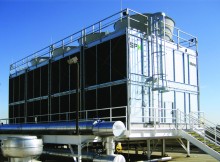College has saved
$1.1 million in
past 23 months
By Amber Quaid / Managing editor
Water conservation is a big part of society and how it functions. Del Mar College is doing its part to join the effort.
Rod Carpenter, MEP superintendent at Del Mar, is one of the decision makers in determining the future of water, electricity and gas conservation on all campuses.
“One of our missions here is to use less water, so in a process we have changed our landscaping, all our new buildings have got native-friendly plants but also we have specs written out to make sure that those plant watering meets certain guidelines,” Carpenter said.
Because of the current water restrictions the irrigation system waters only twice a day, once between 11 a.m. and 1 p.m. and again between 5-6 p.m., for only five to 10 minutes. This is just enough to keep the vegetation alive (brown does not mean dead). The landscaping is done with a zeroscape layout or native plants that use minimal water.
One water conservation process in effect is the variable frequency drive, or VFD. This drive monitors the buildings on campus and the exact needs of each building 24 hours a day, seven days a week. The less water or cooling a building needs, the slower the machine/fans, which in turns means less heat created. Less heat means less water is evaporated and is therefore less is wasted and more is ready to use. According to Carpenter this system has saved $1.1 million in the past 23 months in water consumption.
“It makes it easier (moneywise) on our students,” said Charles Miller, maintenance superintendent. “That’s what I like about it.”
The cooling towers, which use the VFD fans to cool the incoming water, is the current system in place. This system costs less than refrigerate cooling. The steam coming off these towers is part of the cooling process and water loss that must happen to keep the system running. If the system is not monitored correctly, Carpenter said, it can waste 1 million gallons easily. Carpenter and Miller both agree Del Mar water conservation is at the highest level for the state.
“We have other colleges coming to look at what we do,” Carpenter said. “We are on the cutting edge. As soon as the newest technology comes out we get it.”
Another aspect to conserving water is a condensate return capture system. This collects the condensation off the cooling pipes and allows extra water for vegetation that is ready and available without using the city water. The drawback to this system is where to store all that water and then once you have the water you have to use it right away (or it breaks down). This could lead to overwatering or water waste. Though all the issues have not been resolved the projects’ benefits are worth the effort, Carpenter said. This system is part of the November bond for water conservation at Del Mar.
Carpenter also wants to install meters to help control the monitoring of the system and to get rebates from the city. He reports monthly to the city and they keep a log on the water usage and conservation on all campuses. This monitoring will help save water and energy alike.
The water conservation system has a go-green attitude to use the least amount of water and save on production and is also part of the GreenPlumbers. Though Del Mar does not have a water recycling program, mainly because of a lack of enough water available to recycle, the concept is on the next proposal. The newer facilities at the South Del Mar campus will have this system and the condensate return in place, mainly for toilets and water for vegetation. The older buildings at the other campuses have an issue with changing out the plumbing and if the chemically treated water would then be good for the plants.
A water conservation tactic is the placement of the buildings, the design of the buildings and the amount of vegetation surrounding a building. The more concrete you have around a building or the closer buildings are the more heat they create, which means more energy used, which means more water used. The city requires Del Mar to have so much vegetation per area.
“We have to block out parking lots by bushes to meet code,” Miller said.
The newest water conservation system in place that Del Mar students can directly see is the new bottle fill stations. This system will cut down on waste related to improper filling of a bottle and provide information to the student on how much water is being saved. There is one located downstairs at the Harvin Center just outside the bathrooms. The plan is to start off with one fill station in each building, except at the gym where there will be three stations, and then if needed add a second station on another floor.
“We will never not be consuming, we can’t,” Carpenter said. “So we minimize what we consume.”






